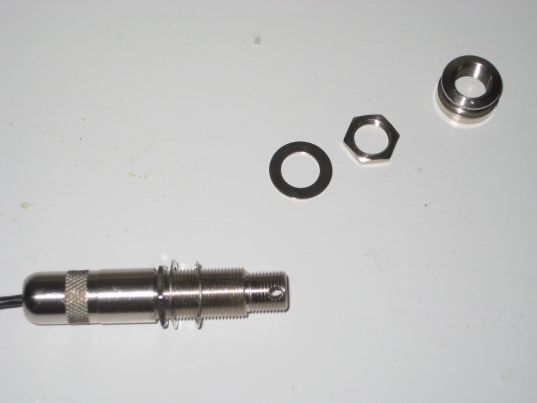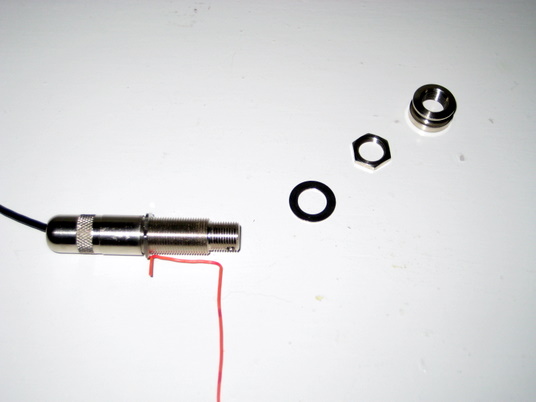Installing an end pin jack
I love the clean, natural sound of an acoustic guitar, but when it’s time to play for a room full of people in a coffee shop, restaurant, or club a pickup inside the guitar comes in mighty handy. There are several different styles of pickups, but they all need a jack so they can be connected to an amp. And installing that jack is a lot easier with a couple of tricks.
I learned a trick back in my electric guitar days that has really come in handy when I install a pickup in my acoustic guitar and I’ve often thought of sharing it, so today I shot a video of the procedure. My video was totally off the cuff with no script, so I forgot to warn about drilling the end pin jack hole, and I’d like to do that now: most of a pickup installation is easily reversible and/or inconspicuous, but it’s all too easy to do real damage to your guitar when enlarging or drilling the hole through the tail block. It’s not hard or dangerous if you know what you’re doing and you have the right tools but it’s not something to try if you don’t. (Now how would I know that??)
The trick involves using a piece of wire or a guitar string to pull the jack into place. All the jacks I’ve seen have hole drilled through the jack at right angles to the plug, and this little detail is a big help in the installation process. Here’s a picture of the end pin jack showing the main body of the jack, the nut and washer that hold the jack from the outside, and the threaded strap button.

Closeup of an end pin jack showing the handy little hole
The larger threaded section needs to be adjusted so it is very slightly shorter than the depth of the tail block, the block of wood inside the guitar. I bend a sharp right angle in the end of the wire and stick that into the end pin jack hole, let it catch on the tail block and use that to measure the depth.

A simple piece of wire measures the end block
If the length here is too great the outer nut will not apply any pressure to the wood and the jack will spin – this is bad. If the length is too short we won’t be able to get the outer nut tightened – this is bad. I usually expect a couple of adjustments to get it just right.
Here’s a video of the complete process:
Have fun and save a few bucks installing your pickup yourself, but just remember, don’t try to drill out that end pin hole if you don’t know what you’re doing or don’t have the right tools.
This entry was posted on Wednesday, February 18th, 2009 at 5:00 pm and is filed under Guitar, Tutorials. You can follow any responses to this entry through the RSS 2.0 feed. You can leave a response, or trackback from your own site.
Robert Mathews said in post # 1,
on February 23rd, 2012 at 9:17 pm
I spoke to Kathy Wingert regarding types of acoustic pickups and she recommended your blog. I want to put a somewhat non-invasive pickup in my Yairi without spending an arm and a leg. Baggs Anthem and Fishman’s Blend cost as much as a kinda decent guitar. I’m trying to decide between the Fishman Matrix Infinity or the Baggs M1 Active. Some of my friends rant about the K&K Western Pure Mini, but I think I’d rather have an active pickup. I love the natural sound of my guitar and I used to just mike it, but got tired of being glued to one place on stage. I’ve been using a Dean Markley ProMag and it sounds okay, I’d just like to have volume control and get rid of the cable hanging out of the soundhole! I’m hoping you’ve checked some of them out and I would appreciate any advice! It’s hard to road test them all!!! Thanks, Robert
Fran Guidry said in post # 2,
on February 24th, 2012 at 12:26 pm
Hi, Robert.
I’ve tried a lot of different pickups and honestly found most of them to be OK but none of them so wonderful that I wanted to adopt them as my standard. The K&K is a wonderful system because it is simple and passive, but requires some extra gear to allow volume control. I’ve been happy with the Baggs Element as well as the Fishman Matrix (pre-Infinity). The newest Fishman RE without the Blend feature is fairly reasonable and has a volume control.
For a minimal cost you could wire up your Markley to an endpin jack and use a cable with a volume control.
Doug Young has a wonderful database of pickups for your listening comparisons: http://www.dougyoungguitar.com/pickuptests/ (He’s a Wingert owner as well).
Fran